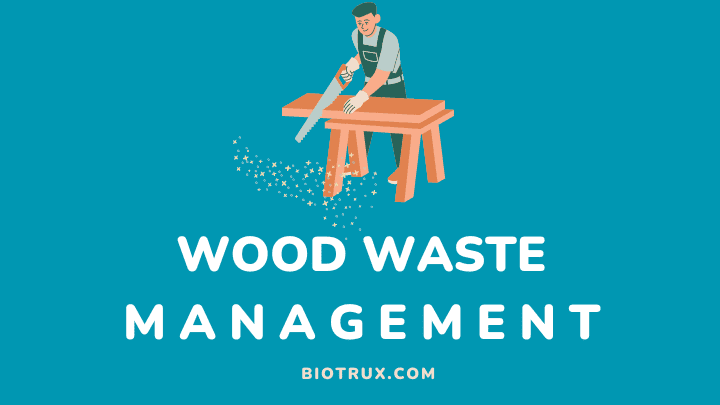As society continues prioritizing sustainability, exploring the best practices and strategies for managing waste materials is essential. From plastic to metal, different types of waste require attention. However, one that particularly stands out is wood waste management.
It’s a common material that households and industries generate in large volumes, and managing it efficiently is crucial to preserve our environment. This article explores the meaning, sources, impacts, and best practices for wood waste management.
This article is an invaluable resource for anyone who wants to minimize the negative effects of wood waste and positively impact the environment.
What is Wood Waste Management?
Wood waste management is reducing, reusing, and recycling waste generated from wood-based products. It involves identifying the sources of waste, establishing a system to segregate the waste, and implementing proper disposal techniques.
Wood waste management aims to minimize the environmental impact of wood production, reduce the amount of waste going to landfills, and conserve natural resources.
Companies can save on disposal costs and generate revenue from selling recycled materials by properly managing wood waste. Wood waste management is an important part of sustainable manufacturing and is increasingly becoming a priority for businesses in the wood industry.
Primary Sources of Wood Waste Generation

The generation of wood waste occurs from various sources, including timber harvesting and processing residues, urban wood waste, and waste from sawmills and wood manufacturers.
Understanding these primary causes can help develop strategies to minimize waste and enhance recycling efforts.
- Timber harvesting and processing residues: This is a significant source of waste wood, consisting of woody forest residues and primary timber processing mill residues. These residues can differ in recyclability, impacting the potential for reuse.
- Urban wood waste: Construction and demolition (C&D) and municipal solid waste (MSW) contribute significantly to wood waste generation. Almost 10% of all material sent to landfills is wood, constituting 20-30% of all construction and demolition debris.
- Sawmills and wood manufacturers: Environmental issues associated with these industries primarily include solid waste generation, air, noise, and wastewater discharge. Minimizing the environmental impacts of timber products throughout production can help reduce waste generation.
- Wood processing industry: As a result of the production process of sawmills, plywood mills, and furniture manufacturing plants, a considerable amount of wood waste is generated daily.
By identifying the primary causes of wood waste generation, measures can be taken to minimize waste and support sustainable practices in the forestry and wood industries.
Environmental and Economic Impacts of Wood Waste
Wood waste management is not just about repurposing wood waste. It also has substantial economic and environmental implications. Learn about them below.
Environmental consequences of improper wood waste disposal
1. Deforestation and habitat destruction
Improper disposal of wood waste can lead to deforestation and habitat destruction. The need for new wood increases due to wasting existing wood resources. This often results in clear-cutting forests to meet the high demand for wood.
Deforestation not only affects the ecosystem but also leads to biodiversity loss. It is crucial to dispose of wood waste in an environmentally friendly way to protect our forests and the planet.
2. Soil and water contamination
When wood waste is not disposed of properly, it can release chemicals into the soil and water. These chemicals can harm plants and animals and make water sources unsafe for human consumption.
These chemicals can also contribute to the formation of harmful algae blooms and other aquatic disturbances, further compromising the health of the surrounding ecosystem.
As such, it is critical to dispose of wood waste responsibly and follow established environmental guidelines. This will minimize these risks and protect our natural resources.
3. Contribution to greenhouse gas emissions
Improper wood waste disposal can have severe environmental consequences, one of which is contributing to greenhouse gas emissions.
When wood waste is dumped in landfills, it decomposes and releases methane, a potent greenhouse gas that impacts climate change more than carbon dioxide. Moreover, if wood waste is burned, it also releases carbon dioxide and other harmful gases that can pollute the air.
To reduce the environmental impact of wood waste disposal, it is essential to recycle and reuse it. This can significantly reduce the carbon footprint and preserve natural resources.
Economic implications of wasted wood resources
1. Loss of potential revenue and economic value
Wasting wood resources can result in a loss of potential revenue and economic value. It takes time and resources to manufacture wood products, and any wasted material means those resources have also been wasted.
When we don’t use wood resources to their fullest extent, we’re not just throwing away wood but also wasting energy, labor, and time. This ultimately leads to decreased economic value and increased costs for producing goods.
We can create a more sustainable and economically viable industry by reducing waste and maximizing our resources.
2. Increased manufacturing costs
As more wood is wasted, the manufacturing costs of products made from wood increase. This is because wasted wood resources increase the demand for new timber, driving up prices.
Additionally, harvesting and manufacturing wood products have become more expensive due to the need to find new wood sources. These factors can lead to higher consumer prices and reduced profits for businesses.
3. Financial burden on waste management systems
Aside from environmental concerns, wasting wood resources can also lead to financial burdens on waste management systems. Landfills are already overloaded with waste, and the addition of wood scraps can contribute to the creation of more landfills or the need to expand existing ones.
Best Practices for Wood Waste Management

1. Source reduction
Reducing waste production at the source is one of the most effective techniques of wood waste management.
Effective manufacturing procedures, ethical logging practices, and sustainable forestry methods can all help achieve this.
Reducing waste output can lessen the environmental effect and protect valuable wood resources.
2. Reuse and recycling
It is vital to focus on reusing and repurposing wood waste. Wood can be recycled and used for various purposes, including construction, furniture production, and crafts.
Furthermore, wood waste can be recycled into composite materials, mulch, or biomass to provide electricity.
Encouragement and assistance for businesses that use recycled wood products contribute to a circular economy and reduce deforestation.
3. Waste-to-energy conversion
Converting wood waste into energy via biomass combustion or gasification is another effective approach. This reduces waste sent to landfills and provides a renewable energy source.
By generating energy from wood waste, we can reduce our dependence on fossil fuels and mitigate our greenhouse gas emissions.
4. Landfill diversion
Implementing strategies to divert wood waste from landfills is crucial. Alternative options, such as composting, can be employed instead of disposing of wood waste in traditional waste management systems.
Wood waste can be transformed into nutrient-rich compost and used in landscaping, horticulture, and soil restoration projects.
5. Education and awareness
It is critical to raise awareness about wood waste management among individuals, businesses, and communities.
Education about proper disposal procedures, recycling options, and the potential environmental and economic benefits of wood waste management can improve practice at all levels. Wood waste can be considerably reduced by developing a waste management culture.
Implementing these best practices necessitates collaboration among various stakeholders, including government agencies, corporations, and individuals.
By implementing these practices, we can reduce the damaging effects of wood waste on the environment and economy while advancing sustainable resource management.
Technological Advancements and Initiatives in Wood Waste Management
The woodworking industry has recognized the need for sustainable practices and is taking strides to minimize wood waste and increase the utilization of wood resources.
Technological advancements like advanced sorting and processing technologies, automation and robotics in recycling and reclamation, and digital platforms and marketplaces for wood waste have significantly reduced wood waste.
Additionally, initiatives such as reusing and recycling wood products have gained traction recently. In fact, some manufacturers are even creating products out of wood waste, such as fuel pellets or compressed wood used in building construction.
These innovative solutions are not only environmentally conscious but also help to reduce costs and improve efficiency in the woodworking industry.
FAQs
Why is wood waste management important?
For numerous reasons, wood waste management is critical. Wood debris improperly disposed of contributes to deforestation, habitat destruction, and pollution. By managing wood waste appropriately, we can conserve our wood resources, limit environmental harm, and reduce greenhouse gas emissions.
How can businesses and industries manage wood waste effectively?
Businesses and industries can efficiently manage wood waste by employing source reduction measures such as streamlining manufacturing processes and practicing responsible logging.
They can also implement recycling initiatives, investigate wood reuse prospects, and study waste-to-energy options to reduce waste and maximize resource efficiency.
How can I determine if wood waste is suitable for recycling or reuse?
Wood waste that is clean, untreated, and free from contaminants such as paint, varnish, or chemical treatments is typically suitable for recycling or reuse. Wood materials like pallets, crates, furniture, and lumber offcuts are often recyclable or can be repurposed for various applications.
Final Thoughts
In conclusion, wood waste management is a critical aspect of sustainability that demands our attention. It affects not only the environment but also our economy and communities. With the right tools and practices, we can minimize the negative impact of wood waste and maximize its potential for reuse and recycling.
Understanding wood waste management can help us to make informed decisions and take action to preserve our environment for future generations. As individuals and organizations, we can all play a vital role in creating a sustainable, waste-free world.
Let’s work together and take responsibility for our wood waste to ensure a brighter future for all.
You can also find out if wood conducts electricity.
Thanks for reading.
